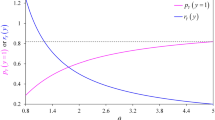Abstract
The existing reliability theory is based on current knowledge of probability distributions and trends of product performances. This article proposes a forecasting method of the product reliability along with the performance data, without any prior information on probability distributions and trends. Fusing an evaluating indicator with five chaotic forecasting methods, five runtime data of the future performance are predicted by current performance data. Via the bootstrap, many generated runtime data along with the performance data are gained, and the predicted reliability function of the product runtime can therefore be established. The experimental investigation on the rolling bearing friction torque shows that the calculated values are in very good accordance with the measured values.








Similar content being viewed by others
References
Sihem, L., Wassila, K., Malek, B.: Transmitter reliability and receiver performance trade-off analysis for transparent satellite communication systems. ICIC Express Lett. 3(3), 247–252 (2009)
Kas’yanov, V.E., Dudnikova, V.V.: Improving machine reliability and efficiency by increasing the fatigue life of the components. Russ. Eng. Res. 29(11), 1083–1088 (2009)
Cadwallader, L.C., Eide, S.A.: Component failure rate data sources for probabilistic safety and reliability. Process Saf. Prog. 29(3), 236–241 (2010)
Kapilesh, B., Yasuhiro, M., Ghosh, A.K.: Time-dependent reliability of corrosion-affected RC beams. Part 2: estimation of time-dependent failure probability. Nucl. Eng. Des. 241(5), 1385–1394 (2011)
Welemane, H., Dehmous, H.: Reliability analysis and micromechanics: a coupled approach for composite failure prediction. Int. J. Mech. Sci. 53, 935–945 (2011)
Mani, S., Ehsan, H., Peyman, F.: Real time reliability study of a model with increasing failure rates. Appl. Mech. Mater. 110–116, 2774–2779 (2012)
Bichon, B.J., McFarland, J.M., Sankaran, M.: Efficient surrogate models for reliability analysis of systems with multiple failure modes. Reliab. Eng. Syst. Saf. 96(10), 1386–1395 (2011)
Yang, S.K.: Failure-processing scheme based on Kalman prediction and reliability analysis for IDF-used 25 kVA generators. J. Fail. Anal. Prev. 11(4), 417–431 (2011)
Asha, G., Unnikrishnan, N.N.: Reliability properties of mean time to failure in age replacement models. Int. J. Reliab. Qual. Saf. Eng. 17(1), 15–26 (2010)
Pan, R.: A Bayes approach to reliability prediction utilizing data from accelerated life tests and field failure observations. Qual. Reliab. Eng. Int. 25(2), 229–240 (2009)
Zhang, J.-P., Wang, R.-T.: Reliability life prediction of VFD by constant temperature stress accelerated life tests and maximum likelihood estimation. J. Test. Eval. 37(4), 316–320 (2009)
Wang, T., Wu, J., Zhang, H.Y., Dai, C.: Reliability design of valve spring based on grey theory. Adv. Inf. Sci. Serv. Sci. 3(8), 219–225 (2011)
Xia, X.T., Lv, T.M., Meng, F.N.: Gray chaos evaluation model for prediction of rolling bearing friction torque. J. Test. Eval. 38(3), 291–300 (2010)
Flouros, M.: Correlations for heat generation and outer ring temperature of high speed and highly loaded ball bearings in an aero-engine. Aerosp. Sci. Technol. 10(7), 611–617 (2006)
Nataraj, C., Harsha, S.P.: The effect of bearing cage run-out on the nonlinear dynamics of a rotating shaft. Commun. Nonlinear Sci. Numer. Simul. 13(4), 822–838 (2008)
Lv, J.H., Lu, J.A., Chen, S.H.: Analysis and Application of Chaos Time Series. Wuhan University Press, Wuhan (2002). (in Chinese)
Lv, J.H., Zhang, S.C.: Application of adding-weight one-rank local-region method in electric power system short-term load forecast. Control Theory Appl. 19(5), 767–770 (2003). (in Chinese)
Sadaoui, D., Boukabou, A., Merabtine, N., Benslama, M.: Predictive synchronization of chaotic satellites systems. Expert Syst. Appl. 38, 9041–9045 (2011)
Sivasamy, J., Che, Z., Wong, T.N., Nguyen, N.-T., Yobas, L.: A simple method for evaluating and predicting chaotic advection in microfluidic slugs. Chem. Eng. Sci. 65, 5382–5391 (2010)
Phillips, F., Kim, N.: Implications of chaos research for new product forecasting. Technol. Forecast. Soc. Chang. 53, 239–261 (1996)
Wu, Z.M., Xia, G.Q., Zhang, Y.: Carrier lifetime variation and its effects on the chaotic behaviors in semiconductor laser. Optik 115(10), 443–446 (2004)
Chang-Jian, C.-W., Hsu, H.-C.: Chaotic responses on gear pair system equipped with journal bearings under turbulent flow. Appl. Math. Model. 36, 2600–2613 (2012)
Zhang, W., Yao, M.H., Zhan, X.P.: Multi-pulse chaotic motions of a rotor-active magnetic bearing system with time-varying stiffness. Chaos Solitons Fractals 27, 175–186 (2006)
Paffrath, M., Wever, U.: Adapted polynomial chaos expansion for failure detection. J. Comput. Phys. 226, 263–281 (2007)
Ionita, S.: A chaos theory perspective on system’s failure. Inf. Sci. 127, 193–215 (2000)
Hu, C., Youn, B.D.: Adaptive-sparse polynomial chaos expansion for reliability analysis and design of complex engineering systems. Struct. Multidisc. Optim. 43, 419–442 (2011)
Cao, L.Y.: Practical method for determining the minimum embedding dimension of a scalar time series. Phys. D 110, 43–50 (1997)
Kantz, H., Shreiber, T.: Nonlinear Time Series Analysis. Cambridge University Press, Cambridge (1997)
Meng, Q.F., Peng, Y.H.: Improved adding weight first order local prediction method for chaotic time series. Comput. Eng. Appl. 43(35), 61–64 (2007). (in Chinese)
Zuo, J., Wang, H., Zeng, Z.F.: An improved model of add-weighted one-rank local-region multi-steps forecasting. Stat. Decis. 24(6), 33–34 (2008). (in Chinese)
Xia, X.T., Lv, T.M.: Dynamic prediction model for rolling bearing friction torque using grey bootstrap fusion method and chaos theory. Adv. Mater. Res. 443–444, 87–96 (2012)
Efron, B.: Bootstrap methods. Ann. Stat. 7, 1–36 (1979)
Acknowledgments
This project was funded by the National Natural Science Foundation of China (Grant No. 51075123) and the Natural Science Research Project of the Education Department of Henan Province (Grant No. 2010B460008), and the Doctoral Scientific Research Initiation Fund of Henan University of Science and Technology (Grant No. 09001318).
Author information
Authors and Affiliations
Corresponding author
Rights and permissions
About this article
Cite this article
Xia, X. Forecasting Method for Product Reliability Along with Performance Data. J Fail. Anal. and Preven. 12, 532–540 (2012). https://doi.org/10.1007/s11668-012-9592-y
Received:
Revised:
Published:
Issue Date:
DOI: https://doi.org/10.1007/s11668-012-9592-y




